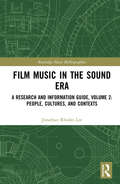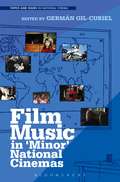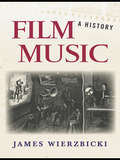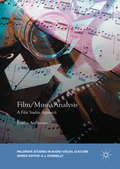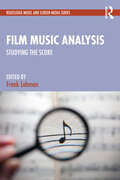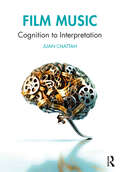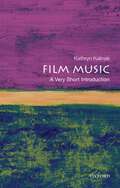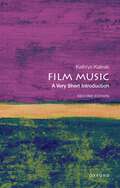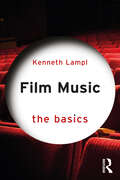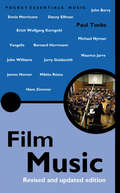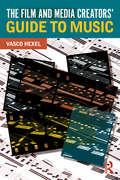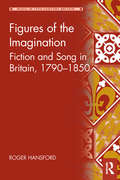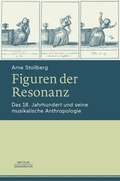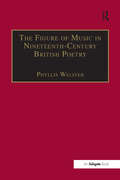- Table View
- List View
Film Music in the Sound Era: A Research and Information Guide, Volume 2: People, Cultures, and Contexts (Routledge Music Bibliographies)
by Jonathan Rhodes LeeFilm Music in the Sound Era: A Research and Information Guide offers a comprehensive bibliography of scholarship on music in sound film (1927–2017). Thematically organized sections cover historical studies, studies of musicians and filmmakers, genre studies, theory and aesthetics, and other key aspects of film music studies. Broad coverage of works from around the globe, paired with robust indexes and thorough cross-referencing, make this research guide an invaluable tool for all scholars and students investigating the intersection of music and film. This guide is published in two volumes: Volume 1: Histories, Theories, and Genres covers overviews, historical surveys, theory and criticism, studies of film genres, and case studies of individual films. Volume 2: People, Cultures, and Contexts covers individual people, social and cultural studies, studies of musical genre, pedagogy, and the Industry. A complete index is included in each volume.
Film Music in the Sound Era: A Research and Information Guide, Volume 2: People, Cultures, and Contexts (Routledge Music Bibliographies)
by Jonathan Rhodes LeeFilm Music in the Sound Era: A Research and Information Guide offers a comprehensive bibliography of scholarship on music in sound film (1927–2017). Thematically organized sections cover historical studies, studies of musicians and filmmakers, genre studies, theory and aesthetics, and other key aspects of film music studies. Broad coverage of works from around the globe, paired with robust indexes and thorough cross-referencing, make this research guide an invaluable tool for all scholars and students investigating the intersection of music and film. This guide is published in two volumes: Volume 1: Histories, Theories, and Genres covers overviews, historical surveys, theory and criticism, studies of film genres, and case studies of individual films. Volume 2: People, Cultures, and Contexts covers individual people, social and cultural studies, studies of musical genre, pedagogy, and the Industry. A complete index is included in each volume.
Film Music in 'Minor' National Cinemas (Topics and Issues in National Cinema)
by Germán Gil-CurielTaking its cue from Deleuze's definition of minor cinema as one which engages in a creative act of becoming, this collection explores the multifarious ways that music has been used in the cinemas of various countries in Australasia, Africa, Latin America and even in Europe that have hitherto received little attention. The authors consider such film music with a focus on the role it has played creating, problematizing, and sometimes contesting, the nation.Film Music in 'Minor' National Cinemas addresses the relationships between film music and the national cinemas beyond Hollywood and the European countries that comprise most of the literature in the field. Broad in scope, it includes chapters that analyze the contribution of specific composers and songwriters to their national cinemas, and the way music works in films dealing with national narratives or issues; the role of music in the shaping of national stars and specific use of genres; audience reception of films on national music traditions; and the use of music in emerging digital video industries.
Film Music in 'Minor' National Cinemas (Topics and Issues in National Cinema)
by Germán Gil-CurielTaking its cue from Deleuze's definition of minor cinema as one which engages in a creative act of becoming, this collection explores the multifarious ways that music has been used in the cinemas of various countries in Australasia, Africa, Latin America and even in Europe that have hitherto received little attention. The authors consider such film music with a focus on the role it has played creating, problematizing, and sometimes contesting, the nation.Film Music in 'Minor' National Cinemas addresses the relationships between film music and the national cinemas beyond Hollywood and the European countries that comprise most of the literature in the field. Broad in scope, it includes chapters that analyze the contribution of specific composers and songwriters to their national cinemas, and the way music works in films dealing with national narratives or issues; the role of music in the shaping of national stars and specific use of genres; audience reception of films on national music traditions; and the use of music in emerging digital video industries.
Film Music: A History
by James WierzbickiFilm Music: A History explains the development of film music by considering large-scale aesthetic trends and structural developments alongside socioeconomic, technological, cultural, and philosophical circumstances. The book’s four large parts are given over to Music and the "Silent" Film (1894--1927), Music and the Early Sound Film (1895--1933), Music in the "Classical-Style" Hollywood Film (1933--1960), and Film Music in the Post-Classic Period (1958--2008). Whereas most treatments of the subject are simply chronicles of "great film scores" and their composers, this book offers a genuine history of film music in terms of societal changes and technological and economic developments within the film industry. Instead of celebrating film-music masterpieces, it deals—logically and thoroughly—with the complex ‘machine’ whose smooth running allowed those occasional masterpieces to happen and whose periodic adjustments prompted the large-scale twists and turns in film music’s path.
Film/Music Analysis: A Film Studies Approach
by Emilio AudissinoThis book offers an approach to film music in which music and visuals are seen as equal players in the game. The field of Film-Music Studies has been increasingly dominated by musicologists and this book brings the discipline back squarely into the domain of Film Studies. Blending Neoformalism with Gestalt Psychology and Leonard B. Meyer's musicology, this study treats music as a cinematic element and offers scholars and students of both music and film a set of tools to help them analyse the wide ranging impact that music has in films.
Film/Music Analysis: A Film Studies Approach
by Emilio AudissinoThis book offers an approach to film music in which music and visuals are seen as equal players in the game. The field of Film-Music Studies has been increasingly dominated by musicologists and this book brings the discipline back squarely into the domain of Film Studies. Blending Neoformalism with Gestalt Psychology and Leonard B. Meyer's musicology, this study treats music as a cinematic element and offers scholars and students of both music and film a set of tools to help them analyse the wide ranging impact that music has in films.
Film Music Analysis: Studying the Score (Routledge Music and Screen Media Series)
by Frank LehmanSince the establishment of film music studies, there has been a steady growth of serious analytical work on the film music repertoire. Film Music Analysis: Studying the Score offers the first collection of essays dedicated to the close investigation of musical structure and meaning in film music. Showcasing scholarship from a diverse and distinguished group of music theorists and musicologists, this book presents the many ways to inspect the inner workings of film music in a manner that is exciting and accessible to anyone curious about this music, regardless of their background in film or music theory.Each chapter takes as its focus one music-theoretical parameter and explores how that concept can be used to analyze and interpret film music. Covering theoretical concepts that range from familiar categories such as leitmotif and pitch structure to more cutting-edge ideas such as timbral associativity, topic theory, and metrical states, the book provides a toolkit with which to explore this captivatingly varied repertoire. With example analyses drawn from classic and contemporary films, Film Music Analysis: Studying the Score is a valuable teaching tool and an indispensable addition to the library of any lover of film and music.
Film Music Analysis: Studying the Score (Routledge Music and Screen Media Series)
Since the establishment of film music studies, there has been a steady growth of serious analytical work on the film music repertoire. Film Music Analysis: Studying the Score offers the first collection of essays dedicated to the close investigation of musical structure and meaning in film music. Showcasing scholarship from a diverse and distinguished group of music theorists and musicologists, this book presents the many ways to inspect the inner workings of film music in a manner that is exciting and accessible to anyone curious about this music, regardless of their background in film or music theory.Each chapter takes as its focus one music-theoretical parameter and explores how that concept can be used to analyze and interpret film music. Covering theoretical concepts that range from familiar categories such as leitmotif and pitch structure to more cutting-edge ideas such as timbral associativity, topic theory, and metrical states, the book provides a toolkit with which to explore this captivatingly varied repertoire. With example analyses drawn from classic and contemporary films, Film Music Analysis: Studying the Score is a valuable teaching tool and an indispensable addition to the library of any lover of film and music.
Film Music: Cognition to Interpretation
by Juan ChattahFilm Music: Cognition to Interpretation explores the dynamic counterpoint between a film’s soundtrack, its visuals and narrative, and the audience’s perception and construction of meaning. Adopting a holistic approach covering both the humanities and the sciences—blending cognitive psychology, musical analysis, behavioral neuroscience, semiotics, linguistics, and other related fields—the author examines the perceptual and cognitive processes that elicit musical meaning in film and breathe life into our cinematic experiences. A clear and engaging writing style distills complex concepts, theories, and analytical methodologies into explanations accessible to readers from diverse disciplinary backgrounds, making it an indispensable companion for scholars and students of music, film studies, and cognition. Across ten chapters, extensive appendices, and hundreds of film references, Film Music: Cognition to Interpretation offers a new mode of analysis, inviting readers to unlock a deeper understanding of the expressive power of film music.
Film Music: Cognition to Interpretation
by Juan ChattahFilm Music: Cognition to Interpretation explores the dynamic counterpoint between a film’s soundtrack, its visuals and narrative, and the audience’s perception and construction of meaning. Adopting a holistic approach covering both the humanities and the sciences—blending cognitive psychology, musical analysis, behavioral neuroscience, semiotics, linguistics, and other related fields—the author examines the perceptual and cognitive processes that elicit musical meaning in film and breathe life into our cinematic experiences. A clear and engaging writing style distills complex concepts, theories, and analytical methodologies into explanations accessible to readers from diverse disciplinary backgrounds, making it an indispensable companion for scholars and students of music, film studies, and cognition. Across ten chapters, extensive appendices, and hundreds of film references, Film Music: Cognition to Interpretation offers a new mode of analysis, inviting readers to unlock a deeper understanding of the expressive power of film music.
Film Music: Music And The Classical Hollywood Film (Wisconsin Studies In Film Ser.)
by Kathryn KalinakFilm Music: Music And The Classical Hollywood Film (Very Short Int)
by Kathryn KalinakFilm music is as old as cinema itself. Years before synchronized sound became the norm, projected moving images were shown to musical accompaniment, whether performed by a lone piano player or a hundred-piece orchestra. Today film music has become its own industry, indispensable to the marketability of movies around the world. Film Music: A Very Short Introduction is a compact, lucid, and thoroughly engaging overview written by one of the leading authorities on the subject. After opening with a fascinating analysis of the music from a key sequence in Quentin Tarantino's Reservoir Dogs, Kathryn Kalinak introduces readers not only to important composers and musical styles but also to modern theoretical concepts about how and why film music works. Throughout the book she embraces a global perspective, examining film music in Asia and the Middle East as well as in Europe and the United States. Key collaborations between directors and composers--Alfred Hitchcock and Bernard Herrmann, Akira Kurosawa and Fumio Hayasaka, Federico Fellini and Nino Rota, to name only a few--come under scrutiny, as do the oft-neglected practices of the silent film era. She also explores differences between original film scores and compilation soundtracks that cull music from pre-existing sources. As Kalinak points out, film music can do many things, from establishing mood and setting to clarifying plot points and creating emotions that are only dimly realized in the images. This book illuminates the many ways it accomplishes those tasks and will have its readers thinking a bit more deeply and critically the next time they sit in a darkened movie theater and music suddenly swells as the action unfolds onscreen. About the Series: Combining authority with wit, accessibility, and style, Very Short Introductions offer an introduction to some of life's most interesting topics. Written by experts for the newcomer, they demonstrate the finest contemporary thinking about the central problems and issues in hundreds of key topics, from philosophy to Freud, quantum theory to Islam.
Film Music: A Very Short Introduction (Very Short Int)
by Kathryn KalinakFilm music is as old as cinema itself. Years before synchronized sound became the norm, projected moving images were shown to musical accompaniment, whether performed by a lone piano player or a hundred-piece orchestra. Today film music has become its own industry, indispensable to the marketability of movies around the world. Film Music: A Very Short Introduction is a compact, lucid, and thoroughly engaging overview written by one of the leading authorities on the subject. After opening with a fascinating analysis of the music from a key sequence in Quentin Tarantino's Reservoir Dogs, Kathryn Kalinak introduces readers not only to important composers and musical styles but also to modern theoretical concepts about how and why film music works. Throughout the book she embraces a global perspective, examining film music in Asia and the Middle East as well as in Europe and the United States. Key collaborations between directors and composers--Alfred Hitchcock and Bernard Herrmann, Akira Kurosawa and Fumio Hayasaka, Federico Fellini and Nino Rota, to name only a few--come under scrutiny, as do the oft-neglected practices of the silent film era. She also explores differences between original film scores and compilation soundtracks that cull music from pre-existing sources. As Kalinak points out, film music can do many things, from establishing mood and setting to clarifying plot points and creating emotions that are only dimly realized in the images. This book illuminates the many ways it accomplishes those tasks and will have its readers thinking a bit more deeply and critically the next time they sit in a darkened movie theater and music suddenly swells as the action unfolds onscreen. About the Series: Combining authority with wit, accessibility, and style, Very Short Introductions offer an introduction to some of life's most interesting topics. Written by experts for the newcomer, they demonstrate the finest contemporary thinking about the central problems and issues in hundreds of key topics, from philosophy to Freud, quantum theory to Islam.
Film Music: Music And The Classical Hollywood Film (VERY SHORT INTRODUCTIONS)
by Kathryn KalinakThe rich and deeply moving sounds of film music are as old as cinema. The first projected moving images were accompanied by music through a variety of performers--from single piano players to small orchestras--that brought images to life. Film music has since become its own industry, an aesthetic platform for expressing creative visions, and a commercial vehicle for growing musical stars of all varieties. In this Very Short Introduction, Kathryn Kalinak takes readers behind the scenes to understand both the practical aspects of film music--what it is and how it is composed--and the theories that have been developed to explain why film music works. This accessible book not only entertains with the fascinating stories of the composers and performers who have shaped film music across the globe but also gives readers a broad sense of the key questions in film music studies today. The updated second edition includes the music from film industries in Africa, Asia and South Asia, and Latin America, and focuses on previously under-represented film musicians, in particular women and minority composers.
Film Music: The Basics (The Basics)
by Kenneth LamplA comprehensive introduction to film music, this book provides a concise and illuminating summary of the process of film scoring, as well as a succinct overview of the rich history of contemporary film music. Written in a non-technical style, this book begins by presenting a brief history of film music from the last 30 years, covering topics ranging from blockbuster franchises to indie film scores. It explores film music from around the world, including Bollywood and European Avant-garde cinema, and film music in animation, like Disney-Pixar and Japanese anime. It then offers a guide to the language of film music analysis, the creative process behind composing film music, and the use of current technology. The book champions diversity in the industry, with case studies and interviews from a range of active film composers, including: Pinar Toprak (Captain Marvel, 2019), Kris Bowers (Bridgerton, 2020), Natalie Holt (Loki, 2021), and Rachel Portman (Emma, 1996), Complete with a glossary of key terms and further reading, this book is an invaluable resource for all those beginning to study film music, as well as lifelong film music buffs seeking to update their understanding of film music.
Film Music: The Basics (The Basics)
by Kenneth LamplA comprehensive introduction to film music, this book provides a concise and illuminating summary of the process of film scoring, as well as a succinct overview of the rich history of contemporary film music. Written in a non-technical style, this book begins by presenting a brief history of film music from the last 30 years, covering topics ranging from blockbuster franchises to indie film scores. It explores film music from around the world, including Bollywood and European Avant-garde cinema, and film music in animation, like Disney-Pixar and Japanese anime. It then offers a guide to the language of film music analysis, the creative process behind composing film music, and the use of current technology. The book champions diversity in the industry, with case studies and interviews from a range of active film composers, including: Pinar Toprak (Captain Marvel, 2019), Kris Bowers (Bridgerton, 2020), Natalie Holt (Loki, 2021), and Rachel Portman (Emma, 1996), Complete with a glossary of key terms and further reading, this book is an invaluable resource for all those beginning to study film music, as well as lifelong film music buffs seeking to update their understanding of film music.
Film Music
by Paul TonksClassical purists say it isn't 'real' music, yet it regularly tops charts and plays to sell-out concert hall audiences. Chart music followers consider the orchestral form passé, yet artists are increasingly sampling from cinema classics. Many cinemagoers are unaware there is music accompanying the films they watch. Some composers say that's the way it should be. Others strongly disagree. This book celebrates the rich history behind all these views.
Film Music: A History
by James WierzbickiFilm Music: A History explains the development of film music by considering large-scale aesthetic trends and structural developments alongside socioeconomic, technological, cultural, and philosophical circumstances. The book’s four large parts are given over to Music and the "Silent" Film (1894--1927), Music and the Early Sound Film (1895--1933), Music in the "Classical-Style" Hollywood Film (1933--1960), and Film Music in the Post-Classic Period (1958--2008). Whereas most treatments of the subject are simply chronicles of "great film scores" and their composers, this book offers a genuine history of film music in terms of societal changes and technological and economic developments within the film industry. Instead of celebrating film-music masterpieces, it deals—logically and thoroughly—with the complex ‘machine’ whose smooth running allowed those occasional masterpieces to happen and whose periodic adjustments prompted the large-scale twists and turns in film music’s path.
The Film and Media Creators' Guide to Music
by Vasco HexelMusic plays an integral role in the experience of film, television, video games, and other media—yet for many directors, producers, and media creators, working with music can be a baffling and intimidating process. The Film and Media Creators’ Guide to Music bridges the gap between musical professionals and the creators of film and other media projects, establishing a shared language while demystifying this collaborative journey. Organized with a modular chapter structure, the book covers fundamental topics including: Why (and when) to use music in a project How to talk about music Licensing existing music Commissioning original music Working with a composer Geared toward emerging and established creators alike, this book takes a practical approach to the process of finding the best music for all forms of moving image. The Film and Media Creators’ Guide to Music offers hands-on advice for media creators, providing readers with the confidence to approach the planning, commissioning, creation, and placement of music in their projects with the awareness, understanding, and vocabulary that will enable them to be better collaborators and empowered storytellers. For students and professionals working across film and media, this book is the essential guide to using music creatively and effectively.
The Film and Media Creators' Guide to Music
by Vasco HexelMusic plays an integral role in the experience of film, television, video games, and other media—yet for many directors, producers, and media creators, working with music can be a baffling and intimidating process. The Film and Media Creators’ Guide to Music bridges the gap between musical professionals and the creators of film and other media projects, establishing a shared language while demystifying this collaborative journey. Organized with a modular chapter structure, the book covers fundamental topics including: Why (and when) to use music in a project How to talk about music Licensing existing music Commissioning original music Working with a composer Geared toward emerging and established creators alike, this book takes a practical approach to the process of finding the best music for all forms of moving image. The Film and Media Creators’ Guide to Music offers hands-on advice for media creators, providing readers with the confidence to approach the planning, commissioning, creation, and placement of music in their projects with the awareness, understanding, and vocabulary that will enable them to be better collaborators and empowered storytellers. For students and professionals working across film and media, this book is the essential guide to using music creatively and effectively.
Figures of the Imagination: Fiction and Song in Britain, 1790–1850 (Music in Nineteenth-Century Britain)
by Roger HansfordThis new study of the intersection of romance novels with vocal music records a society on the cusp of modernisation, with a printing industry emerging to serve people’s growing appetites for entertainment amidst their changing views of religion and the occult. No mere diversion, fiction was integral to musical culture and together both art forms reveal key intellectual currents that circulated in the early nineteenth-century British home and were shared by many consumers. Roger Hansford explores relationships between music produced in the early 1800s for domestic consumption and the fictional genre of romance, offering a new view of romanticism in British print culture. He surveys romance novels by Ann Radcliffe, Matthew Lewis, Sir Walter Scott, James Hogg, Edward Bulwer and Charles Kingsley in the period 1790–1850, interrogating the ways that music served to create mood and atmosphere, enlivened social scenes and contributed to plot developments. He explores the connections between musical scenes in romance fiction and the domestic song literature, treating both types of source and their intersection as examples of material culture. Hansford’s intersectional reading revolves around a series of imaginative figures – including the minstrel, fairies, mermaids, ghosts, and witches, and Christians engaged both in virtue and vice – the identities of which remained consistent as influence passed between the art forms. While romance authors quoted song lyrics and included musical descriptions and characters, their novels recorded and modelled the performance of songs by the middle and upper classes, influencing the work of composers and the actions of performers who read romance fiction.
Figures of the Imagination: Fiction and Song in Britain, 1790–1850 (Music in Nineteenth-Century Britain)
by Roger HansfordThis new study of the intersection of romance novels with vocal music records a society on the cusp of modernisation, with a printing industry emerging to serve people’s growing appetites for entertainment amidst their changing views of religion and the occult. No mere diversion, fiction was integral to musical culture and together both art forms reveal key intellectual currents that circulated in the early nineteenth-century British home and were shared by many consumers. Roger Hansford explores relationships between music produced in the early 1800s for domestic consumption and the fictional genre of romance, offering a new view of romanticism in British print culture. He surveys romance novels by Ann Radcliffe, Matthew Lewis, Sir Walter Scott, James Hogg, Edward Bulwer and Charles Kingsley in the period 1790–1850, interrogating the ways that music served to create mood and atmosphere, enlivened social scenes and contributed to plot developments. He explores the connections between musical scenes in romance fiction and the domestic song literature, treating both types of source and their intersection as examples of material culture. Hansford’s intersectional reading revolves around a series of imaginative figures – including the minstrel, fairies, mermaids, ghosts, and witches, and Christians engaged both in virtue and vice – the identities of which remained consistent as influence passed between the art forms. While romance authors quoted song lyrics and included musical descriptions and characters, their novels recorded and modelled the performance of songs by the middle and upper classes, influencing the work of composers and the actions of performers who read romance fiction.
Figuren der Resonanz: Das 18. Jahrhundert und seine musikalische Anthropologie
by Arne StollbergAb der Mitte des 17. Jahrhunderts vollzog sich in der Medizin ein Paradigmenwechsel von hoher ästhetischer Relevanz. Hatten die Nerven bis dahin als Transportkanäle für die „Lebensgeister“ gegolten, so trat nunmehr eine konkurrierende Theorie auf den Plan, nach der es sich um elastische Fasern handle, die in Analogie zur Saitenvibration, also über das Prinzip der Schwingung zu erklären seien. Der menschliche Leib avancierte buchstäblich zu einem Musikinstrument, das emotionale Erleben (nicht nur) von Musik zu einem Resonanzeffekt. Die Folgen dieser Sichtweise waren einschneidend: Das vorliegende Buch zeigt anhand zahlreicher Quellen aus den Bereichen Musik, Medizin, Literatur und Ästhetik, wie eine „musikalische Anthropologie“ entstand, die wiederum auf die Kompositionspraxis zurückwirkte, etwa bei Carl Philipp Emanuel Bach, Georg Anton Benda und Wolfgang Amadeus Mozart.
The Figure of Music in Nineteenth-Century British Poetry
by Phyllis WeliverHow was music depicted in and mediated through Romantic and Victorian poetry? This is the central question that this specially commissioned volume of essays sets out to explore in order to understand better music's place and its significance in nineteenth-century British culture. Analysing how music took part in and commented on a wide range of scientific, literary, and cultural discourses, the book expands our knowledge of how music was central to the nineteenth-century imagination. Like its companion volume, The Idea of Music in Victorian Fiction (Ashgate, 2004) edited by Sophie Fuller and Nicky Losseff, this book provides a meeting place for literary studies and musicology, with contributions by scholars situated in each field. Areas investigated in these essays include the Romantic interest in national musical traditions; the figure of the Eolian harp in the poetry of Coleridge and Shelley; the recurring theme of music in Blake's verse; settings of Tennyson by Parry and Elgar that demonstrate how literary representations of musical ideas are refigured in music; George Eliot's use of music in her poetry to explore literary and philosophical themes; music in the verse of Christina and Dante Gabriel Rossetti; the personification of lyric (Sappho) in a song cycle by Granville and Helen Bantock; and music and sexual identity in the poetry of Wilde, Symons, Michael Field, Beardsley, Gray and Davidson.
